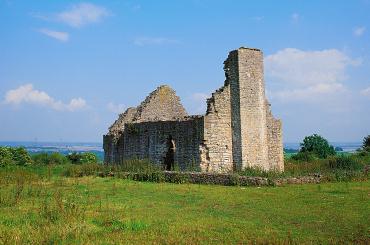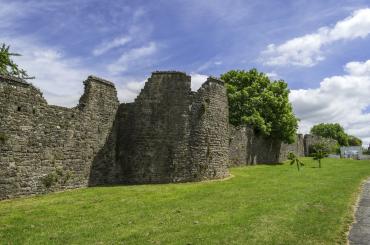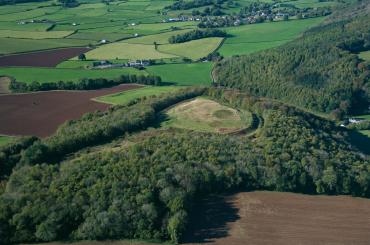Llanmelin Wood Hillfort

Who lived here?
Hillforts constructed by native Britons, or ‘Celts’, in the Iron Age before the coming of the Romans are thick on the ground in Wales. We don’t know for certain who exactly occupied this site high above the Bristol Channel. Llanmelin may well have been home to inhabitants who moved down to nearby Caerwent, established in around AD 75–80. Venta Silurum (Caerwent) was the ‘market town of the Silures’, a native tribe who became Romanised following the conquest of Britain. It may be no coincidence that Llanmelin seems to have been abandoned in around AD 75.
Excavations have revealed that its inhabitants lived in circular houses made of timber and mud, kept cows, sheep and pigs, used pottery, smelted copper and carved antlers from red deer. Surviving earthworks point to a settlement with three distinct features: a main camp, an adjacent annexe (a series of rectangular enclosures) and an outpost in woodland 275 yards/250m away.
Opening times & prices
Opening times
| 1st April - 31st March | Open all year |
|---|---|
|
Open all year — during reasonable daylight hours |
|
Visitor information
Dogs welcome
Walking difficulty
Terrain: Level 3 — Moderate
Drone policy
No smoking
Health & Safety
Care and attention must be paid when visiting this monument. It will be regularly exposed to the natural elements and may be slippery or muddy underfoot.
Appropriate footwear for the season and type of monument must be considered prior to your visit. Please only attend during the set opening hours, these have been chosen for your safety i.e. appropriate level of lighting.
Many of our monuments are located at areas of height, attention must also be paid therefore to the surrounding areas, ditches and moats when visiting.
Guardrails have been installed to prevent access to any areas of the site that we have deemed as dangerous or to prevent falls in specific areas. Please do not climb over or through any fixed installation.
Any handrail provided should be used to help you safely navigate historic steps, as these may be uneven and may be of different height.
As with all ancient monuments there is always a risk of stones being dislodged in bad weather, however, we manage this through extensive monitoring.
Climbing may result in serious injury.
There are several wild plants and flowers, although these are great pollinators, they may be poisonous to visitors and animals, we strongly advise you not to touch or allow dogs to eat any vegetation.
There may be shared access or neighbouring farmland that may involve the presence of grazing cattle or farm animals.
Please watch our health & safety film before visiting Cadw sites.
Iechyd a Diogelwch / Health and Safety
Please report any anti-social behaviour such as climbing, setting fires, graffiti etc. to CadwAccidentsReports@gov.wales
The following signs can be found around the site at key areas of risk, please pay attention where appropriate.
Slippery or uneven surfaces
Falls from height
Low light
Directions
Google Mapwhat3words: ///dude.prom.tungsten
No designated parking
Related
Unlimited access to Wales' past
Join Cadw for as little as £2.00 a month and gain unlimited access to over 100 historical sites.
Enjoy the many benefits of Cadw membership
- 10% off Cadw gift shops
- 50% off entry to English Heritage and Historic Scotland sites
- FREE entry to English Heritage and Historic Scotland on renewal
- FREE entry to Manx National Heritage properties
- FREE membership pack including car sticker and full colour map



